#mainstream sellout icons
Photo

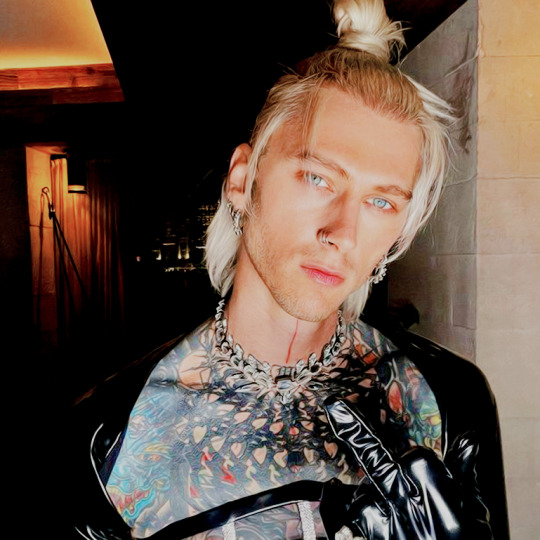

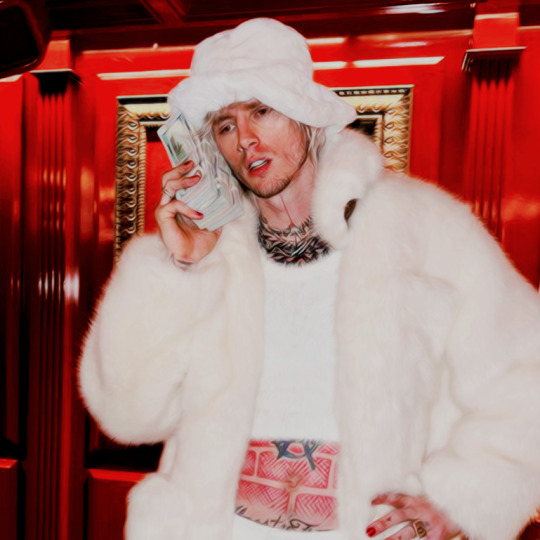
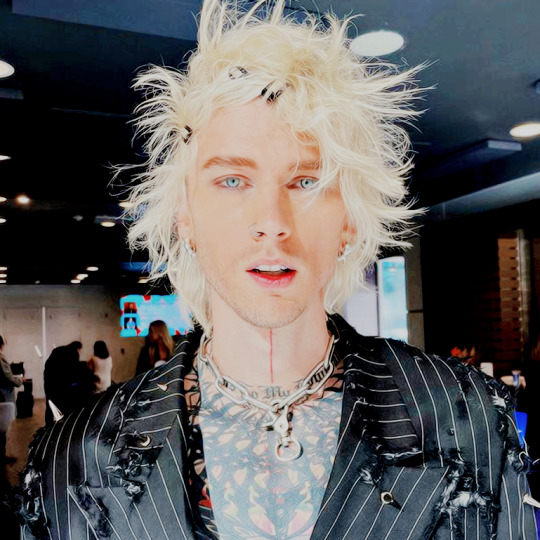

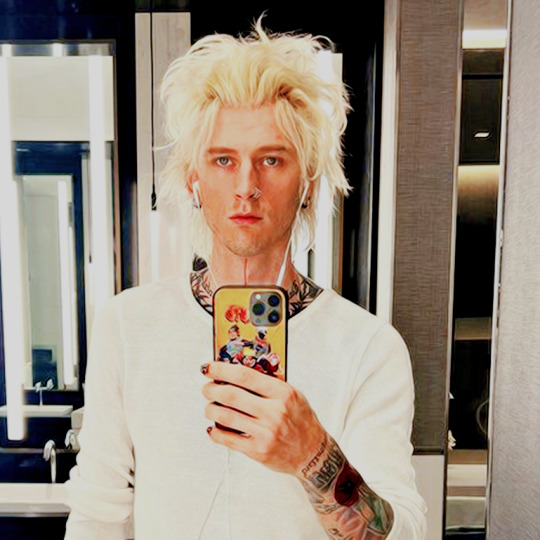

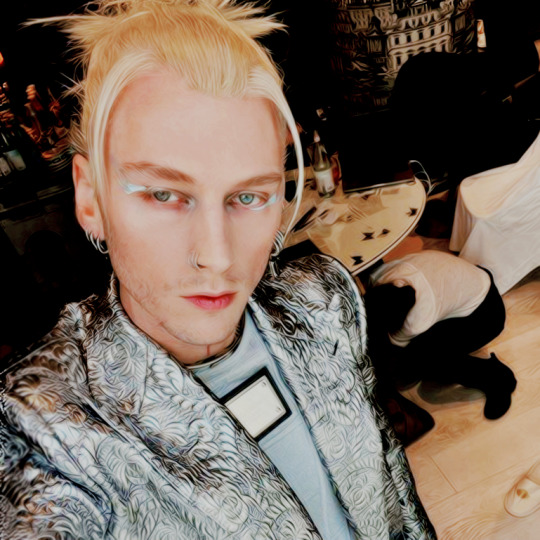
𝐌𝐀𝐂𝐇𝐈𝐍𝐄 𝐆𝐔𝐍 𝐊𝐄𝐋𝐋𝐘 ㅡ 𝐈𝐂𝐎𝐍𝐒
Like if your save or use, please!
#xbkicons#machine gun kelly#mgk#colson baker#machine gun kelly icons#mgk icons#colson baker icons#mr pink#mr pink icons#taurus#taurus icons#machine gun kelly and megan fox#machine gun kelly and megan fox icons#mainstream sellout#mainstream sellout icons
14 notes
·
View notes
Text
Machine Gun Kelly’s No Sellout, But He Took The Mainstream By Storm In 2022
Machine Gun Kelly’s No Sellout, But He Took The Mainstream By Storm In 2022
When haters (and MGK himself) told Machine Gun Kelly, “leave the scene, you’re ruining it,” they should’ve been prepared to stand corrected. Kells kicked down the doors and redefined what it means to be mainstream throughout 2022, which saw the release of his iconic mainstream sellout album, a whole lot of hits, and amazing growth in his personal life. We got to know Colson more than ever before…

View On WordPress
#2022 music#born with horns#colson baker#entertainment#Entertainment News#entertainment news file#est 19xx#estxx#Machine Gun Kelly#mainstream sellout#Megan Fox#mgk#mgk taurus#Music#Music news#one way movie#taurus movie#twin flame#year in review
3 notes
·
View notes
Text
you'rе no icon, you're just a parody
Machine Gun Kelly - mainstream sellout
0 notes
Text









like or reblog if u use
#spotify#icons#icons twitter#twitter icons#boys icons#aesthetic icons#male icons#random icons#machine gun kelly icons#machine gun kelly#colson baker icons#colson baker#maybe#maybe icons#bring me the horizon#mainstream sellout#mainstream sellout icons
98 notes
·
View notes
Photo
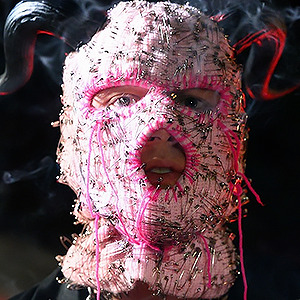
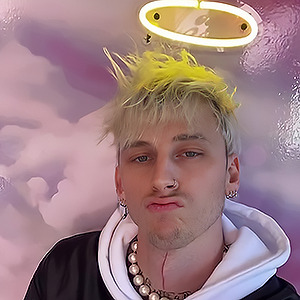


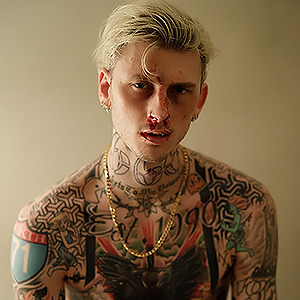

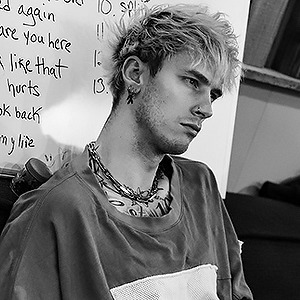


#machine gun kelly#machine gun kelly icons#icons machine gun kelly#mgk#mgk icons#icons#boys#boys icons#males icons#twitter stuff#twitter icons#without psd#colson baker#colson baker icons#icons colson baker#hotel diablo#mainstream sellout#tickets to my downfall#make up sex#kiss kiss#bloody valentine#forget me too#emo girl#maybe
71 notes
·
View notes
Text

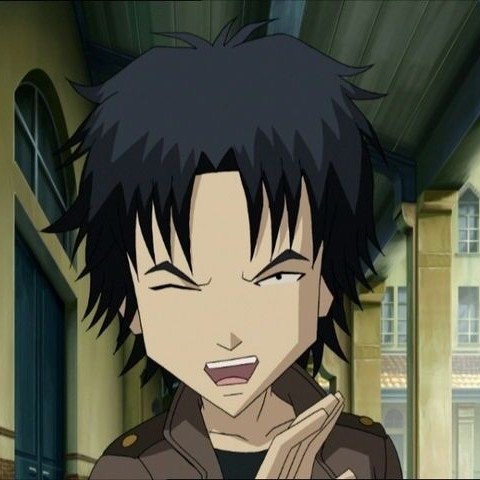

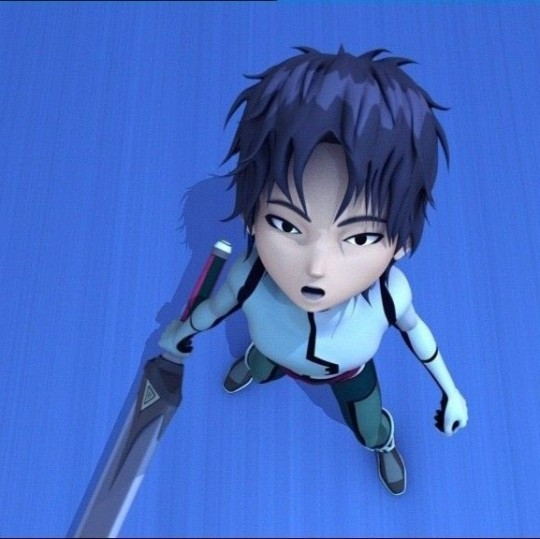

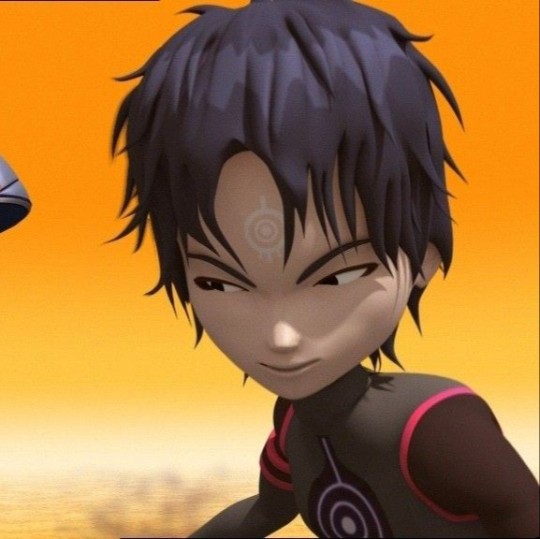


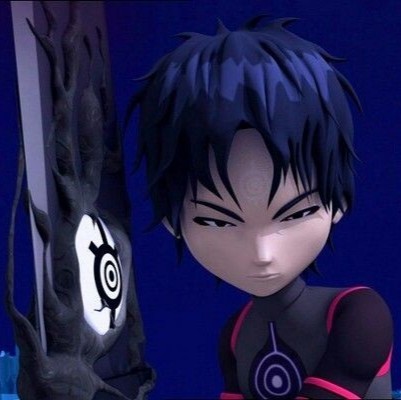
reblog ! if u use
#spotify#series#series icons#aesthetic#icons#aesthetic icons#code lyoko#code lyoko icons#code lyoko william#code lyoko william icons#william#william icons#fale love dont last#mainstream sellout#machine gun kelly#colson baker#iann dior#boys icons#male icons
68 notes
·
View notes
Text
MGK Concert
6/17/2022
This will be my first happy post, because I’m still riding on the serotonin as long as I can. I went to my first concert ever. I saw Machine Gun Kelly on his Mainstream Sellout tour. I always wish I could see my favorite artists/bands live when they are in their sort of “prime” and doing their iconic albums. Such as blink-182 during EOTS/TOYPAJ/Untitled era, MCR during Three Cheers, Taking Back Sunday during Tell All Your Friends, and etc. With MGK bringing upon this punk/pop rock renaissance, releasing Tickets To My Downfall, and Mainstream Sellout, I knew I had to go as I feel to me, this is “his prime” with punk/pop rock rather than this rap.
I chose to wear a black mask (yes, I still wear a mask despite everyone else not anymore, but I just like to hide my face in public now) as a sort of fashionable color choice, my 3 rubber bands as usual, and my blink-182 Untitled T-shirt. I didn’t have any MGK shirts but I thought people also sometimes wear band shirts of old 80′s, 90′s or 2000′s bands anyway. Also, MGK has taken inspiration from blink-182 on occasion and well has worked with Travis Barker on a lot his punk/pop rock songs, so it should be fine. Anyways, I got there and I like how it’s an indoor stadium since it’s hot as hell here. We had seats which is nice in case you get tired. But honestly, for most of the concert I was standing up. The opening act had iann dior and blackbear, and they were honestly awesome. I’ve listened to some of their music before so it did sound familiar, but I definitely plan to check them out more. The best part was that MGK came in with a huge helicopter prop and it was such an introduce with “born with horns” playing, honestly one of the best album intro songs. Everyone was absolutely hyped and I for the first time “danced” in public, I was rockin out, whipping my hair back/forth/sideways, jumpin up and down, and singing along (I’m glad I knew a lot of the lyrics to the songs). It was a side of me I never thought I’d show in public. I love the whole theme of everything, the props, “the internet”, the alien, the devil and angel, and god the interaction with the crowd. It was such a great performance and story playing out. I also loved the transition from WWIII to WW4, genius. I am glad I went to this tour cause I got the best of both TTMD and Mainstream, which are my favorites from him of course. So it truly was the best concert I could’ve gone to of his in my opinion, as it also had blackbear and iann.
I think what I loved most was that I got to be surrounded by people that share this common interest for MGK and his music, and this genre in general. A lot of us have obviously gone through dark times, struggles, conflicts, and are still going through it. I love how for one night, we can put that shit on hold and just have fun for those 4 hours, just this once at least. It boosted my serotonin to the highest it’s ever been in years... Thank you MGK and the fans that went. I can honestly say it was the best time of my life ever. I’ve never felt so alive, and I still think about the concert everyday since then. I was finally able to be myself for once. I’m going to try to make this serotonin last as long as I can.
-Effy
4 notes
·
View notes
Text
CONCERT REVIEW: MACHINE GUN KELLY W/ AVRIL LAVIGNE AND WILLOW AT ROGERS ARENA - JULY 23RD, 2022
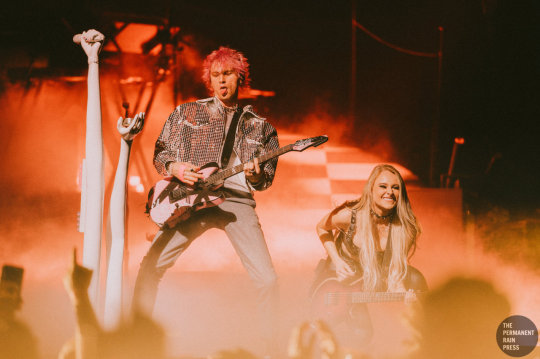
Golden light poured over industrial structures in the heart of Downtown Vancouver. On an event-filled Saturday evening, concertgoers at Rogers Arena experienced an exquisite indie punk rock performance from WILLOW, who joined Avril Lavigne and Machine Gun Kelly on the latter’s Mainstream Sellout tour.
WILLOW always maintains a balance between ethereal vocals and striking instrumentals. Whether she cranks out indie-pop hits or forays into punk rock, WILLOW’s art always feels new, fascinating, magnetic–and genuine. To hold such an authentic appeal whilst landing multiple viral hits on TikTok is no easy feat.
A massive white tarp hung behind the stage with a symbol etched in sharp black marker. The symbol, contained within a circle, housed a symmetrical floral design. In the foreground, a giant “W” cleverly enclosed the remaining letters of the singer’s name. Carved silver trash cans lined the stage, luminous light shining from inside.
WILLOW was accompanied by a full-fledged rock band: steely electric guitars, deep bass, and fierce drums. She dispersed her setlist, drawing from albums lately I feel EVERYTHING, ARDIPITHECUS, and THE ANXIETY.
“I knew a boy just like you / He’s a snake just like you / Such a fake, just like you / But I can see the truth.”
WILLOW’s vocals were light, full, and powerful. Beautiful vibrato circulated throughout the arena: a venue known for being sonically difficult to master. The performance was full of wonderful contrasts and passionate lyrical stings. WILLOW moved loosely and with poise across the stage. A rainbow knitted beanie bounced around on her head and played off nicely with the black t-shirt and pants adorned with warm colourful patches.

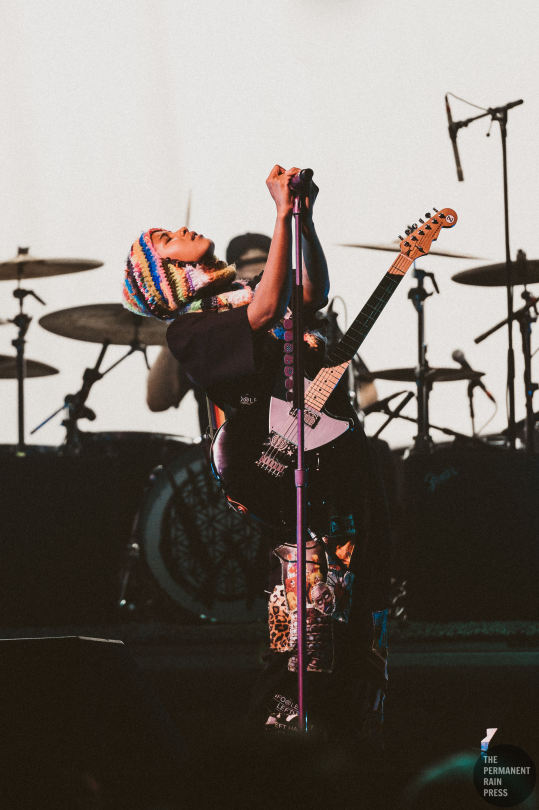
“I really love this next song cause it’s very ugly out here on earth–but sometimes it can be kinda really, really beautiful,” said WILLOW before launching into “Lipstick.” Booming vocals cascaded and harmonized over shredded guitar and heavy drums. “And I’m looking at pain like my old close friend / Open arms for her when I see her again.”
The pace simmered with “Come Home,” a pristine pleading for love. “I’m tired of this feeling, I feel so alone / I need you right now, baby / won’t you come home?” WILLOW’s nuanced melodies and radiant runs weaving into a dramatic chorus.
“It’s kinda cliche,” said WILLOW leading into the song, her soft and kind tone putting the crowd at ease. “But the next song is about being in love.”
“I know we all kinda like being in love, right? Some of us maybe hate it…”
“Meet Me At Our Spot” brought trendy timelessness. The audience erupted in excitement after the first few beat drops and started bobbing along with WILLOW’s heartfelt vocals. “Caught a vibe / Baby, are you coming for the ride? / I just wanna look into your eyes / I just wanna stay for the night.”
Wavy guitars paved a scenic detour away from punk rock with “Wait a Minute!” – WILLOW’s dynamic vocals adding a bold flair compared to the studio recording. “Hold on, wait a minute / Feel my heart’s intention, oh / Hold on, wait a minute / I left my consciousness in the sixth dimension.” To end off the beachy psychedelic rock tone, WILLOW strapped on an electric guitar and played a rich solo melody.
“<maybe> it’s my fault” was a strong end to a captivating performance. Luscious, soft vocals blended into enthusiastic electric strums during the verses, while tension built with a thundering tempo change during the chorus of the track. Screamo vocals cut an intense, cathartic edge.
“It’s all on my mind, it’s all on my mind / I try to rewind / And all of the while / I’m hurting inside / It’s your fault / Maybe it’s my fault.”

Up next, Avril Lavigne. An icon in the punk rock world and Canadian music scene. Lavigne played classics like “Girlfriend,” “Complicated,” “Sk8er Boi,” and “I’m with You.” She also played some tracks off her new album, including “Bite Me” and “Love It When You Hate Me.” Lavigne was energetic and joyous, soaking in the audience’s adoration who knew much of the words to the songs she played.
Machine Gun Kelly (MGK) took the stage from a life-size pink helicopter attached to the arena’s ceiling. He played through most of Mainstream Sellout, including “born with horns,” “god save me,” “make up sex,” “emo girl,” and “die in california.” He also played some tracks off Tickets To My Downfall, including “kiss kiss,” “drunk face,” “bloody valentine,” and “my ex’s best friend.” MGK even performed “el Diablo,” a track from his rap days.

MGK’s stage was a giant optical illusion. A “slanted” checkered circle platformed the band. He wore a glittery tank top and pants with his pastel pink hair. His performance was vibrant and lively. MGK seemed comfortable with the crowd, complimenting the city’s water, donning a purple Vancouver Canucks Hockey Fights Cancer jersey, and walking through the floor crowd during multiple songs. The Mainstream Sellout tour revolved around defeating the internet, which was personified as a giant human figure with a television on its head.
MGK was charismatic and lively, clearly bringing out all the stops for the tour. It was impressive to see old and new guards of punk rock come together for a nostalgic and unique event. Fresh, skilled sounds collided with extraordinary spectacles in a jam-packed concert.
Written by: Jenna Keeble
Photographed by: Timothy Nguyen
#Jenna#Jenna Keeble#PRconcert#concert review#review#Music#live music#Rogers Arena#Willow#Willow Smith#MGK#Mainstream Sellout#Mainstream Sellout Tour#Vancouver#yvr#Machine Gun Kelly#Colson Baker#Avril Lavigne#concert#Tickets to My Downfall
2 notes
·
View notes
Text
2022 music recs for tahlia
bc fuck only having this for anime, this is just everything i’ve downloaded this year
albums/eps
alec benjamin - not scene but still emo af - (un)complimentary
as it is - i went to hell and back
avril lavigne - love sux (i don't have the whole album but there are a few fun ones)
beach bunny - they had an ep didn't they i dont' remember (i didn’t download it)
boston manor - datura coming soon
coldrain - nonnegative
the faim - talk talk
hot milk - the king & queen of gasoline
knuckle puck - disposable life
loveless - end of an era
mgk - mainstream sellout
no pressure - no pressure
panic - viva las vengeance
pinkshift - love me forever (coming soon)
royal & the serpent - if i died would anyone care
set it off - elsewhere
silverstein - misery made me
sws - complete collapse (coming soon)
stat - f.e.a.r.
champs - kings of the new age
tmp - tiny moving parts
wallows - tell me that it’s over
the wonder years - the hum goes on forever (coming soon)
young culture - you had to be there (coming soon)
yours truly - is this what i look like?
yungblud - yungblud
5sos - 5sos5 (coming soon)
singles
atc - wildfire
atl - are boring and just covered blinding lights
beach weather - unlovable
bearings - hello, it's you (deluxe) had a new song, shanking in your mind i think it is
bmth - strangers
broadside - one last time
can’t swim - fail you again (deluxe) has one single new song, i didn’t listen to the og enough to know which one’s new
crooked teeth - i want out & sugarcoated (new ep when?)
dear youth (feat broadside) - juice
driveways - lights on long island (and i bet a new ep in october)
ed sheeran - the fact taht there is a version of bad habits with bmth throws me off every time i remember it exists
ekoh & loveless - wayside
ftw - concrete walls
futuristic & loveless - dead to me
halflives - dynamite
halsey - so good
hot mulligan - drink milk and run & covered makedamnsure
in her own words - circles
john floreani - good boy
john the ghost - young at heart
kids in america & grayscale - my youth is wasted
luke bodine - tailspin
maggie linderman - how could you do this to me?
the maine - loved you a little
movements - barbed wire body & cherry thrill
mcr - the foundations of decay
neck deep - stfu
noahfinnce - after therapy
outline in color & loveless - do your worst
p!nk - irrelevant
ptv - pass the nirvana
point north - dark days & recover
real friends - always lose
royal & the serpent - happier in hell
ryan oakes - burnout
scene queen & set it off - barbie & ken
sigrid - bad life (up there as one of my fav songs of the year)
stuck out - split in two
taylor acorn - psycho
trophy eyes - nobody said (new album when?)
parx - funeral gray & self sabotage (tbh they make me hype for the new album i’m scared)
ymas - deep cuts & no future? yeah right
yungblud - the emperor
things i haven’t listened to but know they released new shit
cemetery sun
icon for hire
jenna mcdougal solo project
the arn-horn sisters have a duo
nothing,nowhere. did a lot
tpr
the regrettes
willow
1 note
·
View note
Photo

HERE’S WHAT YOU MISSED THIS WEEK (3.16-3.22.22):
NEW MUSIC:
Pop-punk quartet Signs of Progress released the second song off of their upcoming EP last Friday, titled “Black and White.” The Static Hero is scheduled for release on April 15.
Magnolia Park and Action/Adventure released a new collab song titled “Deja Vu.” The song follows on from the former band’s previous collaboration with guardin titled “Storm Clouds.”
Simple Plan announced the details of their long-awaited new album titled Harder Than It Looks. Dropping on May 6, the album features their previously-released collab with Sum 41’s Deryck Whibley titled “Ruin My Life.”
Nova Twins shared a new track from their upcoming album Supernova titled “Cleopatra.” The album is set for release on June 17 via Marshall Records and features their previous singles “K.M.B.” and “Antagonist.”
After releasing the song a couple weeks back, Mod Sun has now released a choreographed music video for the song “Rich Kids Ruin Everything.” The song follows on from his previous collab “Down” with Travis Barker.
Spanish Love Songs released a new version of one of their songs titled “Losers 2.” It comes off of their upcoming reworked album Brave Faces Etc., releasing on April 15 via Pure Noise Records.
Scary Kids Scaring Kids shared another track from their upcoming full-length Out of Light. The new song, “Nightmare,” features Ice Nine Kills vocalist Spencer Charnas.
Machine Gun Kelly and Bring Me the Horizon released their highly-anticipated collab called “Maybe.” The pair first premiered the song at Emo Nite in Los Angeles a few weeks back.
Weezer released the first single from their new four EP project SZNZ with a song called “A Little Bit of Love.” The first EP, SZNZ: Spring, arrived this past Sunday on March 20, the date of the Spring Equinox.
VUKOVI released a new single titled “Lasso,” their first new music of 2022. The band are currently on the road supporting Creeper across the United Kingdom and will also appear at 2000 Trees later this summer.
Lights released a new music video for her latest single “In My Head” featuring Twenty One Pilots’ Josh Dun. This is the pair's second collaboration, with Josh previously appearing on “Savage” from the Skin and Earth album.
TOUR ANNOUNCEMENTS:
Sad Summer Festival announced the lineup for its third annual run. The lineup includes Waterparks, Neck Deep, Mayday Parade, State Champs, Hot Mulligan, Against the Current and The Summer Set, with Magnolia Park and LØLØ on select dates.
Machine Gun Kelly announced his headlining Mainstream Sellout World Tour dates. All UK/European dates will have support from Iann Dior and 44phantom, while U.S. dates include Avril Lavigne, Travis Barker, blackbear, Trippie Redd, WILLOW and PVRIS.
Marshall revealed the details of The Marshall Hootie: Loud at Sixty, which will take place on May 6 at Viaduct Meadow in Hanwell - the birthplace of the first Marshall amp. The event will be headlined by Frank Carter and the Rattlesnakes.
OTHER NEWS:
Green Day’s iconic album American Idiot is now certified 8x Platinum in the United Kingdom. The albums closest to it in terms of certification are Dookie, which is currently 3x Platinum, and International Superhits, which is 2x Platinum.
___
Check in next Tuesday for more “Posi Talk with Sage Haley”!
#sage haley#posi talk#signs of progress#magnolia park#action/adventure#simple plan#mod sun#machine gun kelly#bring me the horizon#weezer#green day#nova twins#spanish love songs#scary kids scaring kids#vukovi#lights#frank carter and the rattlesnakes
4 notes
·
View notes
Note
3, 16 & 23?
3. who do you think is/ are the most overrated artist/ band?
there are so many artists, even ones that i love, who i'd call overrated, but i think the only person who can take the title of "most" is beyoncé. sometimes the way people talk about her, it's like they forget that she's a mainstream, incredibly wealthy pop star. she's hyped up as such a revolutionary figure, as a groundbreaking icon, but while she is iconic and has made good music, i find the dissonance between "lemonade is a powerful black feminist masterpiece" and "lemonade wasn't on spotify for 3 years bc beyoncé wanted to make more money off it" a lot to take, even though i did think the album was fantastic. there are limits to how much i will view a mainstream pop star's work as revolutionary.
16. how do you feel about artists “selling out”?
i feel like the concept of selling out is subjective, because some people will label any move towards more mainstream music styles as a sellout, while i always see it as putting chasing the mainstream above artistic quality. i suppose that's because i think pop is a legitimate genre with artistic value. sometimed i'll be okay with a what other people call a "sellout" because i disagree on the definition.
in terms of actual sellouts, i just feel sad about the wasted potential. i'm still sad that ellie goulding decided to go mainstream with her third and fourth albums. she wasn't even that far off the mainstream to begin with, and yet there's still a noticeable drop in quality. at least we'll always have lights.
23. what artist can you absolutely not stand?
ajr, absolutely. listening to one of their albums that month i took music recs was an agonizing experience. it was the only album i actually considered bailing on partway. so gimmicky, so shallow, so insufferably millennials-who-say-'adulting'.
2 notes
·
View notes
Text
Not being a fan of horror movies in general, it was on a bizarre whim (mostly driven by my curiosity about any film with such a unique imprint that it is both cult and mainstream and somewhat driven by depressive dissociation that makes me avoid doing productive things) that I decided to watch Hellraiser a couple days weeks ago (this post has been getting bigger in my drafts for a while- who is keeping time in quarantine dates are arbitrary). About which I knew nothing whatsoever except that it was the thing Pinhead was from and maaaaybe something vague about the existence of cenobites in general from having seen action figure packaging. As I gather is most non-horror people’s experience with the franchise.
Anyway, I watched it and because I am a strange obsessive person I did the thing I always do, which is compulsively seek out ways to stay with an interesting/significant film to grok it better and listen to people talk about why they think it’s good, so I learnt about the sequels without watching them. Finally relented and watched first 2 and then later 3 as I got more and more sucked in to having Opinions about this property which is so totally not my thing lmao.
Anyway, in my post-tros defiance I might have been even more primed than usual for this kind of deep commitment to my brand, but it is made shockingly easy by this series to not only root for and woobieise Pinhead, but to ship him with the main heroine/closest thing it has to a consistent protagonist and needless to say I’ve fallen into a bit of a rabbit hole.
(Yes, friends, I am now going so hard that I am woobieising and shipping an edgelord horror icon with pins stuck in his face. I who am not even a villain fucker. Allow me to reiterate that it is STARTLING how easy they make it and there’s an entirely plausible leg to stand on that both are well-founded in canon. I don’t know what I expected from these movies or that character but it definitely wasn’t this. Did not anticipate, would not have imagined.)
Enormous amounts of incoherent rambling under cut
Out of the gate, none of the Hellraiser films are exactly masterpieces (I mean, I only actually watched the first three, however all reports are that they don’t get better), but they are different and interesting. I completely get why the original is considered a classic and why there are dedicated fans who want to see it taken seriously. There’s enormous potential on the table, loads of creativity and ideas, it’s just that it was never organised into something that hung together and transcended. The first one is contained and narratively solid including some symbolic depth, the second one is an ambitious mess with no plot and which completely falls apart around half way through, and the third one is goofy/not a little bit of an Americanised dumbed-down sellout but again reasonably solid.
But it never really was or became the thing I think the biggest fans saw or remember seeing in it. I’ve run across a couple people mentioning that they went back to watch them again after years and it was a very different experience than they expected from their recollection. The aspects with the greatest popularity/longevity were very minor, almost incidental elements of the original. More hints than anything fully formed. Really, I feel like this becoming a franchise was built on two things:
1. the impressive SFX, originally used to serve resonant themes and well supported by everything around it (especially the score)- the original being just a solid little movie with a very effective hook (lol, see what I did there- hooks, cenobites, get it?)
2. Pinhead.
Well, to be fair, it’s the incredibly memorable and instantly timeless character designs of the cenobites in general, with Pinhead just being by far the most compelling and the only one who’s really a character rather than a prop. He's an extremely arresting and visually interesting figure who also had all the best lines, played by an actor with more charisma in his part than anyone else in the film, and he has an enormous weight of intrigue about him.
People really wanted to see something come of this character, something to make good on the strange gravitas he has, but then it never happened. I really think that frustration is what kept this thing going for thirty years- audiences kept saying ‘more Pinhead’ and neither they nor the filmmakers seemed to know what they wanted from that ‘more’ or how to do it. Other than the tragedy of their humanity in Hellbound (almost completely wasted- the moment of connection with Kirsty is brilliant and seems so promising, then nothing comes of it but a staggering anti-climax where they all die in seconds to beef up a new villain), the vaguely suggested idea of what the cenobites are in the original film is infinitely better than any subsequent expansion on them. Although the third movie at least leans in to the pathos and nuance of the character by expanding on Elliot Spenser (the human who became Pinhead) even while eroding it by having ‘Unbound’ (aka cut off from his humanity) Pinhead become a slasher villain.
It’s all a fortuitous accident that no one ever figured out how to respond to, since Pinhead only got all the lines and became so prominent in the first place because two of the other three cenobite actors were unable to speak in their makeup. He wasn’t even conceived as the focus among the group, he became ‘Lead Cenobite’ (his credited name) because he could talk. They didn’t anticipate the way the audience latched on to him at all and didn’t plan the things which caused it. He is so striking because his look is the most uncanny (his form is most recognisably human, his mutilations are most subtle, but that makes it all the more unsettling to see this obviously living person who has quite a soft countenance and carries himself with a sort of melancholic, kingly dignity have a bunch of nails driven into his skull) and he’s so interesting because the dichotomy of that creates an immediate implication of pathos.
And I’m now experiencing enormous frustration with something that should be fucking predictable at this point, which is the mostly male, mostly powerlevels orientated online fanbase completely missing the boat on who this character is. Totally failing to pick up what was actually compelling about him or why they think he’s awesome besides his general aura of dangerous majesty, which is basically entirely a product of the actor’s stage presence and comportment in synergy with the costume. It’s not what he does because he barely does anything until the third film (which a lot of these fans don’t like anyway). Diving into various reviews and retrospectives about the franchise, I heard so many times a dude saying he hated that Pinhead was given a backstory and especially that it was implied to be the tragic downfall of a sympathetic character. They all had the same reasoning- it’s bad because ‘humanising the monster’ is bad, as it removes their threat.
Oi yoy yoooooy. Let’s break down what’s wrong with that:
a) Pinhead (and by extension cenobites in general because they are a unit in the first film) was not the villain of the story, he’s not even a villain. Frank and Julia are the villains. When the sequel was greenlit, it was intended to be Julia’s villain origin story and she was to go on to be the big bad of the series. The cenobites are neutral and operate according to rules by which no one who faces them is wholly innocent or unwilling. The only time someone opens the box with a true absence of desire (Tiffany, who solves puzzles by compulsion not conscious will), Pinhead orders she be spared without any stipulations or exchange and leaves her to wander around the labyrinth as she pleases. But you can make a deal with the cenobites even if you’re not wholly innocent as long as you are extremely careful, because they can be reasoned with. They are like very dark Gothic faeries (or maybe genies) in the original film. They are amoral rather than being evil. It’s a very ‘careful what you wish for’ kind of situation. They are repugnant in their extremity but terrifyingly recognisable, holding up a mirror to fundamentally human vice.
The cenobites actually stand between Frank and Julia and victory over good. Pinhead saves Kirsty’s life in both the original and the sequel. These movies aren’t ever the most coherent even at their best, so it’s fuzzy, but he even says ‘this is not for your eyes’ to Kirsty before they reclaim Frank. Which implies he actually values her remaining innocence and wouldn’t have her traumatised (yes, they then go after her, I did say this movie isn’t super consistent- but one could argue they think she reneged on her deal by saying she won’t give them ‘the man who did this’- which she still thinks is her father at that point, and also that they never actually promised her anything). The cenobites aren’t here to rip up innocent victims, they expand the awareness of consenting burn outs for whom there are no other thrills left. I understand in the original novella there’s a much stronger element of ‘are you sure you want this?’ before the chains come out. Either way, the overall momentum is that they don’t do anything to people who don’t summon them or call to them in some way. Kirsty was curious and knew the box was dangerous, so there was both knowledge and desire involved in her solving it.
(BDSM is icky icky nope, one of my biggest squicks, but this movie has nothing to do with real life subcultures or the practice of real fetishes- it’s a fable about vice and how it can consume us. Frank is a sociopathic hedonist in pursuit of ultimate pleasure, Julia is so self-absorbed and bored with her life she’ll do anything to get back the thrill she got from Frank, Elliot was a soldier traumatised by WWI who turned to novel corporeal experiences in attempt to feel anything- to believe he was alive [this is implied, not fully spelled out but I am inclined to read Elliot as tragic because even Julia is a nuanced character with whom we can empathise during her downfall so it would be consistent and because he is infinitely more interesting that way]. The attractive quality of the cenobites is their representation of taboo in abstract, of liminal experience and arcane knowledge, not any expectation that one would actually enjoy having hooks through one’s face and find that appealing. To me it’s obviously not about anything so literal as something you might actually do in real life. Which is why it was silly for BDSM ‘lifestyle’ people to be offended by it or say it’s a negative portrayal. It’s not a portrayal, it has nothing to do with them. It’s not a condemnation of your gimp outfit, it’s dealing with universal primal themes with heightened stakes. One of the writers and the actress who played Julia both said the same thing.)
b) Literal monsters are never as scary or as evil as humans. It’s not the cenobites and their strangeness you have to fear most, but the very familiar and mundane sins of humanity- lust, greed, selfishness, gluttony, etc. Again, Frank and Julia are the villains. Julia is the really horrifying element of the film because she is a normal person who becomes so profoundly corrupted that she starts enjoying hammer murders for their own sake, and what makes it scary is that she is at first somewhat sympathetic. We’re with her, in her pov, for quite a bit of the film. This is the effectiveness of well-written horror (horror which creates an atmosphere of dread around a story we’re invested in rather than just throwing out cheap jumpscares and gore), it puts you in an emotionally uncomfortable position as a viewer, so that you are in a state of constant tension.
c) One of the most unique and fascinating things about these films is their surprising empathy and indulgence in romanticism. Humanising monsters and monsterising humans is the DNA of this universe and that’s exactly why the first two films stood out so much. It’s not a flaw! It’s why we’re still talking about it! If not for romanticism and pathos, it would be a boring little cautionary tale about obsession. Gothic romance and tragic monsters, grotesques, the B&tB element??? it’s all part of the backbone and is strongest in the original two films! for real!!!! all the human villains are in love. they all wax poetic about the beauty in ugliness. the heroine shows the monsters their lost humanity!! Pinhead elects to save her even before being stripped of his supernatural powers and turned physically human- meaning it’s not as simple as him being split into two halves (where only the entirely human version of him would care about her) or just human solidarity on his part. There is something personal and special in how he treats her compared to any other character who solves the box. He has always liked her.
Then these grim, bloody horror movies throw me the weirdest bone in the second and third films. So I was just interested in the first film as a notable moment in cinema and had a vague curiosity about its concepts. No actual emotions about it except as noted. I was general audience and my thoughts were basically that, although it was a fun little British horror movie with fairly strong character work, the popular appeal was almost entirely based on how cool the cenobites look. Everyone being most attracted to Pinhead because he looked coolest and he spoke and had this tremendous presence. That was where I was at as well. But my love of behind the scenes info got me watching sequels and BRO- Kirsty, the heroine, discovers a picture of Elliot in his army uniform in Channard’s collection of Research Material. She finds him familiar, pockets the picture, and at some point either then or later realises that he is Pinhead. Already my ears have perked up because the fact that she can recognise him is indicative of unexpected attention to his face on her part (because he is not easily recognisable as the same person at all).
And, armed with this picture and this knowledge, she eventually tells him who he is (the cenobites were not even aware they were once mortal and didn’t remember their human lives). He then fights on her behalf before being gradually depowered to human, sharing a moment with her as the man she freed, and finally sacrificing himself to allow her to escape. That’s movie 2.
Hell on Earth (movie 3) has the entire plot being about his humanity as essential to balancing the power/appetite of the thing he became. So now his worst instincts/pure appetite is walking free without his conscious mind to control or temper it. The ‘ordered’ part of him which followed rules and just had a job to do came from him being human. Not sure what the implications are on that, that’s the opposite to how things usually work in these stories- humans are always free will/chaos and the supernatural entities are bound by rules. Anyway. He’s separated into ‘Unbound’ Pinhead and the ghost of Elliot.
Tragically, Kirsty is not in this movie and thus is not the one who gets to meet his ghost (which, interestingly, seems to be the complete person Elliot was in life- apparently nothing in the cenobite part of him is essential to his personality or being, Unbound Pinhead is just his physical body animated by accumulated bad juju), talk to him, and eventually restore him to one piece, but I’m still into it as a concept (and I like Joey from Hell on Earth, she’s a decent character, it would just mean so much more if it were Kirsty). Despite the rejoining scene being quite awful and then undermined as pointless because he just keeps on being evil (or maybe they haven’t fused yet and both wills are battling it out in there temporarily- did I mention these movies aren’t super coherent a few times already?), the basic idea is there. Huge thematic potential.
And I feel like the vibe of Gothic Romance was pretty blatant and intentional in Hellbound (#2) when Kirsty reminds him of his humanity. He fights and then dies for her, after all. They give him a real, full-on Hero Shot both when he fights as a cenobite and especially after he’s become human and decides to go down with a weapon in his hand. And the look between Elliott and Kirsty before he's killed contains novels imo. That five seconds is the most interesting thing in this entire franchise for me, I would absolutely not have watched more of the films or spent however long rambling here about it if not for that moment. The latest sequel which shouldn’t exist did do one great thing for the world (the world in this example being me) and that’s have him end up human again at the end. Which led to this fanfic, which is the spectacular domestic angst hurt/comfort I needed and need right now.
But Hell on Earth seems to be very much romanticising him deliberately as well. I’ve seen someone claim it was originally written for Kirsty and there would have been a ~vibe between she and Elliot, possibly a kiss. I do not know if any part of that is at all true, but I wouldn’t be super shocked if it was. It’s not implausible. In fact, I find it very plausible. That’s the size of the B&tB monstershipping bone this franchise has unexpectedly thrown me: I could believe it of them to go there. (Apparently they do kiss in a vision or something in one of the comics but the plot and characterisation of the comic continuity also sounds completely off the rails awful so I will not be reading those.)
(Sidebar: The funniest shit I’ve ever heard was from a video about the Kirsty/Pinhead(and/or Elliot) ship wherein it was noted some people object to it because of the age difference.
The age difference.
So, we live in a world where purity wankers can watch and enjoy a Hellraiser movie but are worried about an age difference being problematic. Not his being an amoral genie from the pain dimension covered in mutilations and in the habit of torturing people, but being older than her. Hellraiser has multiple skinless people, flesh vampirism, dudes getting torn apart by chains, a super molesty uncle who wants to rape his niece, murder, sadism, etc. But an age difference is problematic. And which age difference? Because I bet you three million dollars they don’t give a fuck that Elliot/Pinhead is over a hundred years old in the context of the story (he is a WWI solider who became immortal, I remind you). It’ll be about the physical age difference between the actors. Anyone who brings this shit up is always completely predictable and completely shallow. I don’t know what their age difference actually is (it doesn’t look that big lmao, it never even occurred to me to wonder), but she’s definitely an adult so there is no possible scenario in which it matters.
Honestly though. Imagine being okay with this franchise in general and then trying to play the ~problematic age difference~ card. Kirsty feeds her douche husband and four other people to Pinhead in one of the latter day DTV sequels (not literally- he does not eat people. Feel like I should note that for anyone who isn’t familiar still reading this out of morbid fascination with my descent into madness).
Okay, I looked up the actors- they’re only 12 years apart LMAO who cares. Weak.)
Speaking of which (his popularity). Why are people so down on Hellraiser 3 (Hell on Earth)? Pinhead’s OOC behaviour is explained (to the extent than anything is ever explained in this universe) and his character is actually deepened (which people complain about more than the fact that he’s unhinged and Evil McEvilface? which thing actually bothers you, I’m confused? either you like that he’s not a monster or you don’t- everyone says the first two are the only good ones but Pinhead was humanised and made tragic in the second one, he also sacrificed his life to save Kirsty and they ALSO say the third one is lame because he’s made into a slasher villain without nuance??), but I see so much complaining about the less serious tone and wisecracks etc. Meanwhile. Hellbound has even more puns/dumb villain wisecracks than Hell on Earth does.
Channard is non-stop ludicrous as soon as the tentacle attaches to his head. And Hellbound also has not one, but two big floppy anti-climaxes and is narratively entirely pointless. 3 is a much better movie. Yes, Hellbound had tonnes of interesting ideas and evocative visuals, but it doesn't actually make any sense and there's no arc for anyone. There’s no plot, there’s no conflict which gets resolved unless you count the brief moment Channard enjoyed being a classic cenobite before he was taken over by the giant prehensile penis. What the fuck was that anyway? Who knows. Nothing about it is ever explained. The tentacles were also shown pounding the nails into Elliot’s head in Pinhead’s origin montage, so one imagines it must be Leviathan. But why would Leviathan take over Channard directly and why would it cause him to become an Austin Powers villain? When the original cenobites fight him, does this mean they are rebelling against Leviathan itself?
Like, someone who thinks this movie is a masterpiece should really try to make an outline for what the fuck it’s about, because it makes no sense even on a solely thematic or symbolic level.
I think that while Hell on Earth is far, far more pedestrian than the first two films and much less thoughtful, it's pretty much on par in regard to execution. The rich atmosphere and striking novelty of the original hugely elevated it, but it's rough in a lot of ways. The bad dubbing, the weird pacing, characters behaving bizarrely to make the plot work, massive logic holes you actually notice while you're watching (if you don't notice them until the third time, then they don't matter- but if you're asking 'wait what?' and thinking about that instead of being engaged in the story then it does matter), some cheesy dialogue, some weak blocking of scenes, how blasé the cinematography sometimes is, etc. What was brilliant about it was its ideas and its visuals, what made it stand out was that it was doing something radically different than its contemporaries. Hell on Earth abandons the serious dramatic tone and becomes more bog standard horror schlock with bog standard set pieces, but its plot and mythology makes just as much sense and the production aspects are just as good or better if less ambitious and less inventive.
I don't find it worse as a piece of entertainment, just commercialised and gentrified to the original's organic auteur flavour. Clunky, creaky creative vision from an artist is preferable to a sleeker, more soulless product, but Hell on Earth isn’t a soulless product imo. It legitimately tries to do something cogent and worthwhile which shows a love of the material, it makes an effort with its characters, it just lacks in execution. It lacks finesse, strangeness, and subtlety in a really big way.
You know, the super try hard ‘I’m so edgy’ church scene (which is dumb on numerous levels), the lametastic and instantly dated ‘modern’ cenobites, the heavy metal club, the crassness of it in comparison to the more elegant, seductive qualities of the first two. etc. etc. Those things drag it down. The bungled writing and terrible visuals of the final showdown with Unbound Pinhead drag it down (I’d argue the original suffers similarly and Hellbound even more so from illogical, dorky climatic showdowns- honestly what bothers me about Hell on Earth is the goofiness of the visual more than anything else- the climaxes of the first two were dramatically empty added action where this one actually had a lot going for it, but they shot it so badly and the special effects are both badly conceived and badly executed. Why shoot Pinhead in an extreme close-up fish eye lens?? Why make a horrible blob morph?? looking regal and dignified is at least 75% of his effectiveness as a character!!). But it hangs together and flows well. It doesn’t bore me and only left me asking ‘what?’ once or twice instead of fairly regularly. In Hellbound you ask ‘what?’ approx once every other scene if you pay too much attention.
There’s no consistency to this shit. Whatever. Anyway. They’re still trying to do a remake and I’ve never heard anything so ill-advised and utterly pointless. What worked and created something special wasn’t the raw material from the story, people don’t remember the film for its plot and don’t want to see that story executed better or with ‘better’ modern effects (not that it would be better, it’ll be all CGI and have infinitely less impact- the original works because it’s visceral, tangible, fleshy). There’s only one icon from this franchise and he can’t be replaced because it was the marriage of actor and image which created him. The scripts never really understood the character’s final form and it’s already been demonstrated that anyone else in the costume looks like they’re playing dress up and is instantly rendered ridiculous when they speak.
What was needed was a better sequel with a meaningful story that did the character justice so the audience could feel satisfied the opportunity was seized and the most was made of him, and that tragically never happened. 2 and 3 make some effort, but the scripts just aren’t there. Then, no one after that ever considered trying to create closure for Kirsty or giving some kind of emotional throughline to the actual Hellraiser narrative with the only other remaining OG- the one who has the special relationship with Pinhead. Instead they just threw him into unrelated horror scripts haphazardly because people wanted to see him.
There’s absolutely no profit in going back to the beginning and starting over now, the thing that had so much potential and deserved to be explored won’t be there.
And in meaningless observations I must put somewhere lest I continue to think about them for the rest of my natural life: it’s weird that the most popular official art of Pinhead is apparently from early proof of concept photos they did when they were still figuring out the make up. I know this because he has blue eyes in it instead of the black sclera contact lenses he has in the movie. Those pictures were used for the sequel promo as well! The cover of the sequel OST is a different photo also without contacts, at least three notable posters are therefore from those concept pictures. No one who shows those photos in their videos about the series has ever mentioned this, so I feel compelled to mention it.
(I would guess it must be because they had no idea he was going to become the face of the franchise and so didn’t have other promo pics prepared/money to do a new shoot when the audience decided who the poster boy should always be. They were making the sequel before the first film even came out, so they didn’t know the reaction until production was well underway. Still, you’d think in making the film’s main theatrical poster they would have rectified this jarring inconsistency. It’s wild to me it was used not only for the original, but the sequel. It’s so noticeable! Those black lenses aren’t subtle!
Actually wait, I was going to add images here to show the nobody who will read this wall of text how noticeable it is and discovered a sequel promo pic without contacts that was definitely shot for the sequel because it has the female cenobite played by a different actress. The plot thickens on this completely trivial and uninteresting mystery no one but me will ever care about. So idk, maybe they lost the contacts? Why do I want to know? I want to know.)
Anyway look:
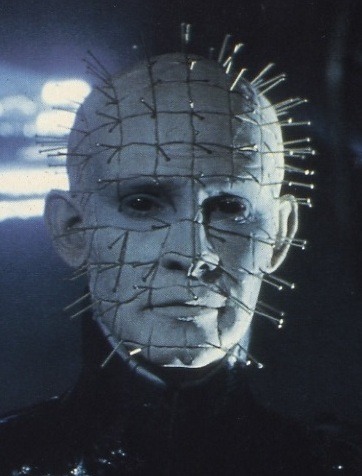
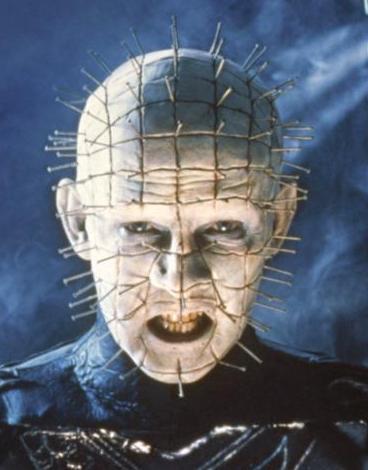
Super noticeable, right? His real eyes are such a pale blue, it stands out even more than it otherwise would. I was like ‘why does that famous poster image look so strange to me now that I’ve seen the film...? oh!’ and then became desperate for someone else to point it out lmao. Yes, I am crazy, why do you ask.
And the other one is that there’s something wrong with his makeup in Hellbound during the scene where he gives Kirsty the pyramid version of the box. The prosthetic is super thick/maybe not applied properly? around the jaw and it bothers me every time someone shows clips from that part.
#pinsty#hellraiser#Pinhead#this isn't a review this is a pool of mental vomit#mostly meta#with some criticism and me not even really talking about the ship which is what I started this post to talk about#anyway I'm doing a painting of Pinhead now#my defiance might be part of an ongoing emotional meltdown#who can say#if there is any more soft domestic shipping fic from the fandom days of yore someone link it to me#incongruous fluff is keeping me alive right now#maybe I also like it because while it's brutal and full of ugliness it's genuinely not cynical#good-hearted characters triumph in the Hellraiser films- evil is a self-consuming choice people make out of selfishness#there is strong empathy with all the players in the drama- they have comprehensible motives the films don't condemn humanity they depict it#I feel like most horror films are cynical and that probably has a lot to do with my disinterest in the genre#I also don't understand the appeal of being scared on purpose but they generally don't scare me so that's not really the issue#except the Sixth Sense#the ghosts in that got under my skin- ghosts get to me in a way monsters/slashers/etc. don't
36 notes
·
View notes
Link
Ethnic tensions are coming to the fore, but many minorities find solidarity with activists.
Jessie Lau
November 7, 2019, 4:53 PM
A man waves an Indian flag near Chungking Mansions, a popular haunt among minority South Asians and Africans in Hong Kong, as police keep watch at a crosswalk during a pro-democracy rally in Tsim Sha Tsui district on Oct. 27. Philip Fong/AFP via Getty Images
HONG KONG—For Zab, Hong Kong has always been home. While the 25-year-old has roots in Pakistan, he was born, raised, educated, and now works in the city. This summer, Zab—who gave only his last name out of safety concerns—has been a cautious participant in several Hong Kong protests, standing out as one of the few brown faces among the protesters. After tear gas was fired during one rally, he ran into a police blockade as he attempted to flee. Trapped and struggling to breathe, he was terrified of being interrogated. But the police let him pass—a decision Zab suspects was related to his Pakistani ethnicity. “They probably thought I wasn’t a Hong Kong person,” he said.
This year’s protests are bringing Hong Kong’s ethnic tensions to the fore. After a mob assaulted commuters in Yuen Long train station in July, Nepali men in the neighborhood were abused by locals and accused of attacking civilians. Hong Kong’s railway corporation came under fire for reportedly planning a task force of former Gurkhas to enforce bylaws during the crisis because, in the words of a railway executive, “Nepalese do not understand Cantonese, [and] thus they will be less provoked.” Last month, when an assault on the pro-democracy leader Jimmy Sham left him lying in a pool of his own blood, local media claimed his attackers were South Asian without evidence.
Minority leaders rushed to publicly condemn the violence and support Sham—as well as privately urge community members to lie low in case of retaliations. Most recently, after police doused a mosque using water cannons with blue dye to clear a peaceful protest supporting ethnic minorities, demonstrators helped clean the mess and rallied around the community. In a moving show of solidarity, they organized a Thanksgiving gathering at Chungking Mansions, a local hub for ethnic minority workers and asylum-seekers.
Hong Kong’s identity crisis has been exacerbated in recent years. China’s authoritarian interventions have triggered a localist movement and imagined political community that sees itself as culturally, linguistically, and ideologically separate from mainland China. Since Hong Kong was handed to China by the British in 1997, those who identify as Hong Kongers grew from 35.9 percent to a record 52.9 percent this year, according to statistics from the University of Hong Kong’s Public Opinion Programme. Among locals aged 18 to 29, the percentage jumped from 45.6 percent to 75 percent. The trend holds true for ethnic minority families. Older generations are more conservative and wary of politics, Zab explained. “Our families say we are minorities here and don’t have a say. [But] I consider myself a Hong Konger,” Zab said.
Ethnic minorities such as Zab have historically been either tokenized as a symbol of diversity or demonized as scapegoats for Hong Kong’s social problems. But in the current movement, they have become a powerful marker of inclusion—especially in contrast to an increasingly ethnonationalist China, where minority groups are facing linguistic exclusion and mass detention camps.
In Hong Kong, ethnic minorities are defined by the government as people of non-Chinese ethnicity. Yet only those who do not pass as white or Chinese are considered second-class citizens by mainstream society. In 2016, excluding foreign domestic workers, 263,593 people in Hong Kong—3.6 percent of the population—fell into this group. In contrast to the generally aging population and falling birth rate, between 2006 and 2016, the number of ethnic minorities aged 15 to 24 more than doubled, and those born in Hong Kong increased from 24.5 percent to 30.9 percent.
Hong Kong has always been multicultural—not just English and Chinese but an imperial outpost drawing its population from across the British Empire. The South Asian community can be traced to the 1840s, when it defended Hong Kong as soldiers and worked alongside Eurasians as intermediaries between Chinese and Europeans. More than 1,000 Indian soldiers were killed or injured while protecting Hong Kong in the 1941 Japanese invasion. Star Ferry, Hong Kong’s main passenger ferry service, was founded by an Indian Parsi baker.
The British made heavy use of Gurkha soldiers, who helped suppress the 1900 Boxer Rebellion and established today’s Nepali community. Following World War II, inexpensive laborers from the Philippines and other Southeast Asian countries began migrating to Hong Kong to work as foreign domestic workers, supporting an emerging Chinese middle class. In the 1970s, Vietnamese refugees joined them.
Despite such crucial contributions, ethnic minorities remain systematically marginalized. Entrenched language barriers, racial profiling, and poverty remain barriers to integration. Many have long condemned the government’s failure to teach local languages to non-Chinese speakers. Until 2004, children who lacked Chinese proficiency but could not afford international schools were directed toward government institutions targeting working-class minorities, which came with social stigma. Local media and conservative groups characterized them as criminals during a sweeping anti-refugee campaignblaming asylum-seekers for stretching local resources.
While such students can now apply to other institutions, schools have independent selection criteria and are not required to provide specialized curriculum for language proficiency. A 2016 study found that less than 20 percent of jobs advertised online catered to non-Chinese speakers. Nearly one-fifth of ethnic minorities also live below the poverty line, and the poverty rate rose from 15.8 percent to 19.4 percent between 2011 and 2016.
The protest movement is hardly free of discrimination itself. When the anti-extradition protests first erupted, 29-year-old Yasir Naveed, who proudly identifies as a Hong Konger, was galvanized. Donning a white shirt with the rest of the crowd, he marched in the first rally with his 72-year-old father and 4-year-old nephew—a move to express multigenerational support. “My father is part of the senior citizens who built this city,” said Naveed, who is ethnically Pakistani. “And the future is our nephew.”
Fixing the crisis will be risky—but worthwhile for both sides.
Early on, there were already rumors that ethnic minorities were being hired to attack protesters. One day, Naveed received a message from Han Chinese protesters asking him to check the grammar on an Urdu text. It was an appeal from demonstrators asking ethnic minorities not to “accept bribes” to “beat up” protesters. Naveed was stunned. “I was so offended,” he said. He responded saying the message was grammatically correct but ethically wrong. “Did they think we are sellouts? That we’re so hungry and needy for money that a party can buy us?”
The simultaneous co-option and rejection of minorities also occurred in the 2014 Umbrella Movement and 2012 anti-national education protests. Minorities were celebrated by protesters as proof of local inclusion, but their interests were subsumed during broader political discussions, which were largely publicized and conducted solely through Cantonese, with excursions into Mandarin.
Paul O’Connor of Lingnan University called the treatment of ethnic minorities a missed opportunity. “They hold true opportunity for Hong Kong to redistinguish itself as this ‘one country, two systems’ territory because China doesn’t have the history that Hong Kong has in terms of this multicultural heritage,” O’Connor said. “Instead, their interests are being co-opted by the broader fight about Hong Kong identity and then dropped.”
In fact, Raees Baig, an assistant professor of social work at the Chinese University of Hong Kong, said pro-Beijing parties such as the Democratic Alliance for the Betterment and Progress of Hong Kong have more successfully engaged and advocated for ethnic minorities, through establishing outreach centers and English-language materials about government services.
That has left many community leaders carefully neutral. Adeel Malik, the chairperson of the Muslim Council of Hong Kong, exercised caution at present. He strongly condemned the recent violence by all parties, which he said has caused some to consider leaving Hong Kong. “If any of our community members get involved and anything turns into a riot, sadly it can be easy to stereotype the whole community,” Malik said. Arief Wahyudi, a 49-year-old local of Indonesian descent who has lived in Hong Kong for two decades, echoed his sentiments. “Violence will only fuel violence,” he said. “That’s what we’re very scared of.”
Yet there’s no denying that the current movement has brought solidarity among different Hong Kongers on a previously unseen scale—albeit somewhat accidentally. Unlike other protest movements, it has effectively used creative and grassroots messaging to target a global audience—inadvertently extending accessibility to local non-Chinese speakers, said Puja Kapai of the University of Hong Kong.
Many people have been empowered by expressions of unity and have experienced political awakenings for the first time. Han Chinese locals are also becoming more aware of the ethnic minority communities. A local journalist of Pakistani descent became a protest icon after fiercely cross-examininggovernment officials in fluent Cantonese. Various ethnic minority protesters have also been embraced as Hong Kongers. “There have been blessings in disguise,” Malik said.
Jeffrey Andrews, a local social worker of Indian descent who organized the Thanksgiving gathering at Chungking Mansions, said many of the Han Chinese guests had never mingled with ethnic minorities before. “For the very first time, we’ve taken ownership,” he said. “We’ve taken a crisis and turned it into an opportunity.”
As the protests spiral into their 22nd week, Zab’s family and friends have warned him against becoming more involved in the crisis. But in Zab’s eyes, the movement has already entangled Hong Kong’s ethnic minorities, whether they like it or not. “If we consider ourselves as part of Hong Kong, we should be involved in political affairs,” said Zab, who is thinking of running for district council in the future. “We can’t just stay behind the scenes.”
Jessie Lau is a journalist in Hong Kong.
15 notes
·
View notes
Text









like or reblog if u use
#spotify#icons#icons twitter#twitter icons#boys icons#aesthetic icons#male icons#random icons#machine gun kelly icons#machine gun kelly#colson baker icons#colson baker#blackbear icons#blackbear#mainstream sellout icons#mainstream sellout
36 notes
·
View notes
Text
The Black Anglo Saxons
The Black Anglo Saxons
by Darryl James [May 8, 2007]
For all the talk of defining ourselves as African Americans [also known as the melanated], there are those of us who define ourselves based on the culture we have adopted, which is mostly European.
While most of us pretend to be African American, many of us are really Black Anglo Saxons.
James Earl Jones, an icon of the Black Anglo Saxons once mused that there is no Black culture, because culture is shaped by language and our language is English, therefore, our culture can not be anything else.
According to James Baldwin, “The making of an American begins at the point where he himself rejects all other ties, any other history and himself adopts the vesture of his adopted land. In the case of the Negro, the past was taken from him whether he would or no.”
For many of us, Black History begins in [the United States of] America with our ancestors being brought over in chains from savage lands, delivered mercifully to civilization and Christianity, without which we surely would have perished.
And, even after a quiet admission that slavery could not be continued, inequities continued boundlessly, even extending to the chaining and abuse of our self-image and according self-worth.
Even when we were supposedly free, from the end of [chattel] slavery to the end of Jim Crow [legalized segregation] and to the beginning of [social] integration, we were still being captured many times over and lied to about freedom, while accepting the lie of acceptance.
The goal all along has been to fit in, to melt with mainstream society, but many of us have done that so well that we’ve lost our own sense of history and our own sense of culture in favor of a culture that will never accept us.
And even some of us who claim to be Afrocentric know little of that which is intrinsically African.
For example, ask any so-called African American to name three kings or three nations in Africa. Most of us have nothing that shows an intrinsic African understanding. Yet, even Italians who can’t speak Italian know about Italy and Sicily, whether they have been there or not, and many have not.
Hell, many Black Anglo Saxons know about Italy and Sicily, even though they know nothing of Africa as demonstrated by the wretchedly stupid rappers who take names of Italian gangsters with pride.
The point is that even the Black Anglo Saxon who loves the rhetoric of being Afrocentric, has no intention of making a real connection. That’s why we hear talk of how we were once kings and queens, but those same talkers are doing anything but living like the heirs of royal blood.
And, ask them of Africa today, and they believe that the entire continent is rife with AIDS, civil wars and poverty. They accept this dismal view of Africa from American news reports, but have never been to Africa and have never discussed the continent with native Africans.
Many Black Anglo Saxons want to be as quiet and as non-confrontational as possible, which often means exonerating people who commit crimes against our community simply because they have made empty overtures to us as in the case of former President [William Jefferson] Clinton, or when they are causing damage to our image as in the case of 50 Cent.
Blind and silly Negroes are still running around calling William Jefferson Clinton the first Black president, tacitly ignoring the fact that Black college enrollment began to decline and Black imprisonment began a steep incline during his [administration].
And, Black Anglo Saxons are afraid to do what is necessary to garner freedom, which includes chastising our own in order to protect our community. We saw South Africa gain it’s independence with the use of direct and productive tactics, including “Necklacing,” where a tire was foisted around the neck of a sellout, filled with kerosene and set ablaze, ending the life of the sellout and showing the world that the community was unafraid to go to war within and without.
But the Black Anglo Saxon is afraid of real revolution.
When 50 Cent worked with Paramount to assault the inner city Black psyche with him cooning with guns displayed prominently on posters in Black neighborhoods, silly Negroes meekly attacked Paramount and still loved 50 Cent, excusing the moron’s poor behavior simply because he is Black.
The community should have gathered around 50 Cent and [disavowed his behaviour], but he gets defended or even lauded as a role model simply because he is making money. And, some of the same Black men and women who refuse to take him to task, rage loudly otherwise about the destruction done by rappers and rap music, forgetting that Russell Simmons, Puff Daddy [also known as P Diddy] and Jay-Z have all profited from harming our community even as we laud them for amassing cash from doing such harm.
Entertainers in days gone by ranging from Eartha Kitt, Sidney Poitier and Muhammed Ali placed their careers on the line for what they believed, but today, Black Anglo Saxons are more concerned about the entertainer who makes money.
And, Black Anglo Saxons love their well-paid entertainers so much that when one of us attacks a cooning comedian or buffooning rapper, the Black Anglo Saxons will come to their defense. For example, when I attacked Tyler Perry for dressing up like a woman, diminishing the Black male image, while desecrating the Black female image and Black Anglo Saxons from both sides attacked me, seeing nothing wrong with the destruction of our image.
Politically, we can’t even make decisions that will benefit us as a body. Most of us align ourselves with the Democrat[ic Party] -- a party that systematically put Black men out of the house courtesy of the Welfare system and created generations of [Black] women who raised Black children alone and then began to blame the fathers for being absent.
On the other hand, the Republican Party has tacitly ignored the blatant racism and classism in its own party to get some of us to return to their side, while doing nothing for any of us.
We have true models to define our next phase of existence. Those models come from our history in America, and our history in Africa.
The African National Congress (ANC) and the Pan Africanist Congress PAC) were Black governments, even when they had no true governing party. African Americans have no government and no governing party — the Congressional Black Caucus (CBC) is toothless and impotent, governing nothing and not even attempting to.
The Black Anglo Saxon wants nothing more than to be embraced by mainstream America, while separating all ties with the Black Americans who are left at the bottom of society by generations of the cream rising to the top and flowing out of the community.
The Black Anglo Saxons first appeared as free slaves who were accepted in some quarters of white society and so began to pretend at assimilation while looking down at the Negroes they believed “chose” to be left behind.
These new Negroes disconnected from their people and even today, pronounce loudly that “I don’t know nothing ‘bout Africa.”
But Black Anglo Saxons perhaps got the biggest boost in membership after integration, when more Negroes than ever before were allowed into the white world, where they could pretend that they were no longer the same as those “lower economic people” left behind in the economically depressed urban areas all across America.
The Black Anglo Saxon has nerve enough to speak for their brethren left behind, claiming that they are economically disadvantaged because they simply “choose not to do better.” None of the bonehead Black Anglo Saxons has ever asked a Black man or woman in midst of economic depression if they truly have decided not to do better, because to speak for them makes it easier to ignore their need.
If a revolution comes from the impoverished and the strong and the young (and history has shown us that this is where revolutions come from), the first group to be eaten alive by such an animal should be the Black Anglo Saxons, who are more destructive than any seething white racist ever could be.
They are damaging us from the inside.
https://musicbanter.com/song-writing-lyrics-poetry/79770-ghaw2007s-lyrics-collection.html https://futureproducers.com/forums/threads/ghaw2007s-lyrics.523656 https://boards.soapoperanetwork.com/topic/55799-ghaw2007s-lyrics https://allthelyrics.com/forum/showthread.php?t=172944 https://writerscafe.org/ghaw/writing/?&p=2 https://justusboys.com/forum/threads/435561-ghaw2007-s-Lyrics https://musesongwriters.com/forums/index.php?/topic/65827-ghaw2007s-lyrics https://gayheaven.org/showthread.php?t=536605
Racism: A competitive relationship between groups of people who are competing for the ownership and control of wealth and power
WordPress https://ghaw2007.wordpress.com
SongwriterForum https://songwriterforum.co.uk/index.php?topic=11560.0 https://songwriterforum.co.uk/index.php?topic=11546.0 https://songwriterforum.co.uk/index.php?topic=11542.0 https://songwriterforum.co.uk/index.php?topic=11481.0 https://songwriterforum.co.uk/index.php?topic=11474.0 https://songwriterforum.co.uk/index.php?topic=11470.0 https://songwriterforum.co.uk/index.php?topic=11466.0 https://songwriterforum.co.uk/index.php?topic=11464.0 https://songwriterforum.co.uk/index.php?topic=11454.0 https://songwriterforum.co.uk/index.php?topic=11432.0 https://songwriterforum.co.uk/index.php?topic=11403.0
0 notes
Text
Reclaiming Indian Food from the White Gaze
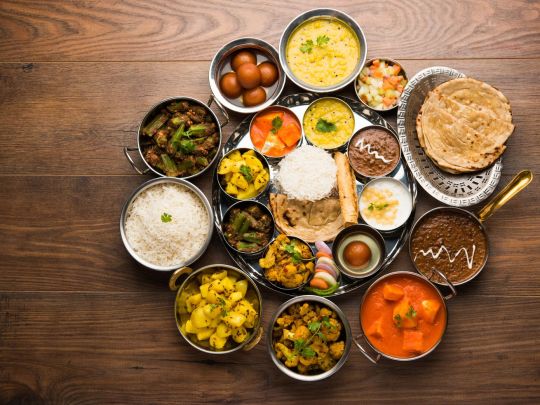
Shutterstock
The same food I was teased for as a kid has become gentrified and endorsed by Goop. Now, I’m using my cookbook to change the narrative.
This is Eater Voices, where chefs, restaurateurs, writers, and industry insiders share their perspectives about the food world, tackling a range of topics through the lens of personal experience. First-time writer? Don’t worry, we’ll pair you with an editor to make sure your piece hits the mark. If you want to write an Eater Voices essay, please send us a couple paragraphs explaining what you want to write about and why you are the person to write it to [email protected].
Once we’d been at home for three months, I finally gave in — not to sourdough, but to starting a quarantine cookbook. At first, it seemed like a fun and lighthearted activity, a way to connect with friends over what we were making. But it turned out to be more emotional than I expected. As an Indian woman working to love my culture in a world that has stolen it from me, food gets very personal.
I was never taught how to cook as a child. My parents don’t cook very often; their specialty is chili cheese toast, and I don’t know any passed-down family recipes. Instead, I learned the basics from Chitra Agrawal’s Vibrant India when I was 21. But even though I was brought up on Indian food, I learned about it through the white gaze.
For many people of color, food can be a source of pride and shame. Growing up, I was mocked for how Indian food affected white people’s digestion. Whenever I went to a British friend’s house for playdates, her mom proudly told me when they ordered Indian food (always curry) and how she was so relieved that this particular restaurant didn’t give her stomach problems. She wanted a pat on the back for bravely ordering ethnic food, but by othering my culture and expecting my validation, she made me uncomfortable.
Slowly, I started absorbing the stigma that others attached to my culture. In fifth grade, my mom submitted a chicken tikka masala recipe to our class cookbook even though we are vegetarians, because it’s always been easier to give the people what they want than to try to educate them. In 10th grade, eating bhindi stained my braces green. In college, my favorite snack was papad, but when my friends started to sniff the air after I made it, I learned to be self-conscious about its smell. As an adult, even my own home could make me feel judged: Whenever I made tadka in my Brooklyn kitchen, the mustard seeds tempering in ghee set off the smoke detector.
But the same recipes I was teased for eventually became chic, gentrified, and endorsed by Goop. Their popularity in the hands of white tastemakers made me realize that people didn’t want to see a brown face behind brown food. I met people who were hesitant to try my homemade nimbu pani, but would happily pay $6 for South Indian filter coffee made by a white woman at Smorgasburg. It’s never been an equal playing field: Brown chefs are expected to cook their own food, but white chefs can cook whatever they want.
I’ve also seen the effects of colonialism in how people explain my own culture back to me, with no awareness of the power dynamics. This happens a lot at restaurants. At Manhattan’s Bombay Bread Bar, a white server felt compelled to explain kulcha to me; farther downtown at Janam Tea, my Pakistani friend and I received a lecture from a white woman who proudly told us how she was bringing Indian tea to the West, without any humility around claiming expertise of a culture that is not her own.
For years, I’ve been working to address culinary imperialism and reclaim my love of Indian food from the white gaze. But while I have been enjoying teaching myself traditional recipes, I often get stuck when none of the options online are written by brown people. It’s become so trendy to remove Indian food from its cultural context — the New York Times’ masoor dal recipe includes sweet potatoes, which would alarm any auntie — that it’s hard to know what’s authentic as someone who’s still learning.
It doesn’t help that in the West, people view Indian food through the lens of takeout, which shortchanges the craft behind it. Many recipes are extremely intricate, with over 10 ingredients and hours of prep and stove time. Even a simple meal requires a quick sequence of actions, serious focus, and lots of multitasking (cue the smoke detector). And yet that effort is often erased by what is familiar: My roommates are cautious about tasting new recipes that I make, and instead keep ordering their usual garlic naan and vindaloo. For all of the parts of my culture that people love, it’s sad to see how much fear still exists.
It’s also jarring to see how the language around Indian food has changed over time, with new recipes branded as ayurvedic, vegan, and cleansing in order to seem more approachable. Ghee, which I grew up thinking was an indulgence, is now a superfood. Khichdi, one of my childhood comfort foods, has been co-opted as kitchari, the latest detox cleanse.
This kind of language belongs to modern wellness culture, which has also made me distance myself from Indian traditions. I would love to learn yoga or meditation, but don’t feel like I have access to them anymore: It’s too painful to learn about my culture from people who can’t pronounce “namaste” (nuh-mus-teh) or “mantra” (mun-tra). “Namaste” is a word that no longer even belongs to us: I cringe when I hear it used in all sorts of inappropriate situations, like as a catchphrase to “namastay in bed.” Its loss echoes the one I felt my first year in New York, when I attended a Diwali puja (prayer service) only to feel sick to my stomach when I realized that I was the only brown person in the room. It’s traumatic to see your culture taken from you.
The same recipes I was teased for eventually became chic, gentrified, and endorsed by Goop. Their popularity in the hands of white tastemakers made me realize that people didn’t want to see a brown face behind brown food.
Still, I’m working to not let my baggage stop me. Three years ago, I went to Patel Brothers, the iconic store in Jackson Heights, to start my spice collection and happily buy katoris that remind me of home. As I learned to cook, I sent my parents photos of pongal, puchka, and pakoras on WhatsApp, hoping that one day I could cook for them. I joined a dinner club, which became my testing ground for new recipes (I was the only person of color), and shared leftovers with my South Asian coworkers for the real verdict. Over Thanksgiving, I observed my aunt’s chai-making process to figure out why my chai tasted like a mouthful of ginger (crushing instead of grating was the trick). I even started improvising with spices, adding chaat masala to popcorn, cucumber, and scrambled eggs.
After going through this journey to reclaim my culture, every decision for my quarantine cookbook feels critical: Each is a chance to change the narrative, even if it’s just for myself. For weeks, I’ve been compiling global recipes from my community, finding ways to bring out personal stories and enjoying the opportunity to learn more about my friends. All of them submitted one or two recipes, mostly ones that are meaningful to them and have been passed down in their families. As the cookbook’s curator, I knew that my recipe would say something about me, and felt a familiar existential crisis coming. If I chose Indian food, I would feel a responsibility to dispel myths, provide regional nuances, and compensate for whitewashed food descriptions (I refuse to call a dosa a sourdough crepe). But if I chose a recipe from a different culture, I would feel like a sellout.
This dilemma reflected a larger one: Representing my culture always feels somewhat performative. In many ways, I’m happy to educate. It’s incredibly important to learn about food from people who come from its culture. But the pantomime required to cheerfully explain the basics and provide emotional reassurance so that other people can get over their fears and assumptions is exhausting.
For this reason, I’ve never felt fully comfortable going to Indian restaurants with non-South Asians. I know that, in some way, I will be responsible for translating the menu, affirming people’s choices, advising on spice levels, teaching them how to eat with their hands, and commenting on whether the food is authentic — a temporary tour guide. But it feels strange to be considered an authority when I don’t always recognize what’s on the menu. There are dozens of regional cuisines within India, but in the U.S., only a handful of North Indian dishes are mainstream, and many of us didn’t grow up eating them. People are always shocked when I tell them that I don’t eat curry, but they don’t understand that there’s so much more to Indian food that I’ve never felt like I was missing out.
This emotional labor is why, without realizing it, I left writing my own cookbook recipe to the last minute. I was delaying the carefully calculated decisions of how to translate ingredients, whether to pick a familiar or niche recipe, and how much to educate. Ultimately I picked chana masala, partly because it’s one of my favorite easy dishes and partly because I wanted it to serve as a wake-up call for people who don’t know the cultural roots of The Stew.
For the introduction, I wrote about how my dad calls me luchi, the Bengali word for puri, a puffy round flatbread that is served with chana masala to make one of my favorite dishes, chole bhature. I explained how, when I was young, I would get excited to order it at restaurants and poke the puri so it would deflate. Now, it’s really special to realize that I can make the chana myself. In writing about this, I found a way to speak about Indian food in a way that felt genuine to me.
Now I’m back in India, and it feels like a dream to not have to carry around the armor. I finally feel like I can learn without judgment, and have already warned various aunties that I’m coming over to cook after quarantine ends. I’m working to sink my feet into the spaces my ancestors created, to unconditionally love where I come from and give myself permission to explore it. It’s always going to be a process, but I want to decolonize my mind and take my power back.
Nayantara Dutta is a writer, strategist, and third culture kid. You can find her @nayantaradutta.
from Eater - All https://ift.tt/3gpntXd
https://ift.tt/2Zn7Ok5

Shutterstock
The same food I was teased for as a kid has become gentrified and endorsed by Goop. Now, I’m using my cookbook to change the narrative.
This is Eater Voices, where chefs, restaurateurs, writers, and industry insiders share their perspectives about the food world, tackling a range of topics through the lens of personal experience. First-time writer? Don’t worry, we’ll pair you with an editor to make sure your piece hits the mark. If you want to write an Eater Voices essay, please send us a couple paragraphs explaining what you want to write about and why you are the person to write it to [email protected].
Once we’d been at home for three months, I finally gave in — not to sourdough, but to starting a quarantine cookbook. At first, it seemed like a fun and lighthearted activity, a way to connect with friends over what we were making. But it turned out to be more emotional than I expected. As an Indian woman working to love my culture in a world that has stolen it from me, food gets very personal.
I was never taught how to cook as a child. My parents don’t cook very often; their specialty is chili cheese toast, and I don’t know any passed-down family recipes. Instead, I learned the basics from Chitra Agrawal’s Vibrant India when I was 21. But even though I was brought up on Indian food, I learned about it through the white gaze.
For many people of color, food can be a source of pride and shame. Growing up, I was mocked for how Indian food affected white people’s digestion. Whenever I went to a British friend’s house for playdates, her mom proudly told me when they ordered Indian food (always curry) and how she was so relieved that this particular restaurant didn’t give her stomach problems. She wanted a pat on the back for bravely ordering ethnic food, but by othering my culture and expecting my validation, she made me uncomfortable.
Slowly, I started absorbing the stigma that others attached to my culture. In fifth grade, my mom submitted a chicken tikka masala recipe to our class cookbook even though we are vegetarians, because it’s always been easier to give the people what they want than to try to educate them. In 10th grade, eating bhindi stained my braces green. In college, my favorite snack was papad, but when my friends started to sniff the air after I made it, I learned to be self-conscious about its smell. As an adult, even my own home could make me feel judged: Whenever I made tadka in my Brooklyn kitchen, the mustard seeds tempering in ghee set off the smoke detector.
But the same recipes I was teased for eventually became chic, gentrified, and endorsed by Goop. Their popularity in the hands of white tastemakers made me realize that people didn’t want to see a brown face behind brown food. I met people who were hesitant to try my homemade nimbu pani, but would happily pay $6 for South Indian filter coffee made by a white woman at Smorgasburg. It’s never been an equal playing field: Brown chefs are expected to cook their own food, but white chefs can cook whatever they want.
I’ve also seen the effects of colonialism in how people explain my own culture back to me, with no awareness of the power dynamics. This happens a lot at restaurants. At Manhattan’s Bombay Bread Bar, a white server felt compelled to explain kulcha to me; farther downtown at Janam Tea, my Pakistani friend and I received a lecture from a white woman who proudly told us how she was bringing Indian tea to the West, without any humility around claiming expertise of a culture that is not her own.
For years, I’ve been working to address culinary imperialism and reclaim my love of Indian food from the white gaze. But while I have been enjoying teaching myself traditional recipes, I often get stuck when none of the options online are written by brown people. It’s become so trendy to remove Indian food from its cultural context — the New York Times’ masoor dal recipe includes sweet potatoes, which would alarm any auntie — that it’s hard to know what’s authentic as someone who’s still learning.
It doesn’t help that in the West, people view Indian food through the lens of takeout, which shortchanges the craft behind it. Many recipes are extremely intricate, with over 10 ingredients and hours of prep and stove time. Even a simple meal requires a quick sequence of actions, serious focus, and lots of multitasking (cue the smoke detector). And yet that effort is often erased by what is familiar: My roommates are cautious about tasting new recipes that I make, and instead keep ordering their usual garlic naan and vindaloo. For all of the parts of my culture that people love, it’s sad to see how much fear still exists.
It’s also jarring to see how the language around Indian food has changed over time, with new recipes branded as ayurvedic, vegan, and cleansing in order to seem more approachable. Ghee, which I grew up thinking was an indulgence, is now a superfood. Khichdi, one of my childhood comfort foods, has been co-opted as kitchari, the latest detox cleanse.
This kind of language belongs to modern wellness culture, which has also made me distance myself from Indian traditions. I would love to learn yoga or meditation, but don’t feel like I have access to them anymore: It’s too painful to learn about my culture from people who can’t pronounce “namaste” (nuh-mus-teh) or “mantra” (mun-tra). “Namaste” is a word that no longer even belongs to us: I cringe when I hear it used in all sorts of inappropriate situations, like as a catchphrase to “namastay in bed.” Its loss echoes the one I felt my first year in New York, when I attended a Diwali puja (prayer service) only to feel sick to my stomach when I realized that I was the only brown person in the room. It’s traumatic to see your culture taken from you.
The same recipes I was teased for eventually became chic, gentrified, and endorsed by Goop. Their popularity in the hands of white tastemakers made me realize that people didn’t want to see a brown face behind brown food.
Still, I’m working to not let my baggage stop me. Three years ago, I went to Patel Brothers, the iconic store in Jackson Heights, to start my spice collection and happily buy katoris that remind me of home. As I learned to cook, I sent my parents photos of pongal, puchka, and pakoras on WhatsApp, hoping that one day I could cook for them. I joined a dinner club, which became my testing ground for new recipes (I was the only person of color), and shared leftovers with my South Asian coworkers for the real verdict. Over Thanksgiving, I observed my aunt’s chai-making process to figure out why my chai tasted like a mouthful of ginger (crushing instead of grating was the trick). I even started improvising with spices, adding chaat masala to popcorn, cucumber, and scrambled eggs.
After going through this journey to reclaim my culture, every decision for my quarantine cookbook feels critical: Each is a chance to change the narrative, even if it’s just for myself. For weeks, I’ve been compiling global recipes from my community, finding ways to bring out personal stories and enjoying the opportunity to learn more about my friends. All of them submitted one or two recipes, mostly ones that are meaningful to them and have been passed down in their families. As the cookbook’s curator, I knew that my recipe would say something about me, and felt a familiar existential crisis coming. If I chose Indian food, I would feel a responsibility to dispel myths, provide regional nuances, and compensate for whitewashed food descriptions (I refuse to call a dosa a sourdough crepe). But if I chose a recipe from a different culture, I would feel like a sellout.
This dilemma reflected a larger one: Representing my culture always feels somewhat performative. In many ways, I’m happy to educate. It’s incredibly important to learn about food from people who come from its culture. But the pantomime required to cheerfully explain the basics and provide emotional reassurance so that other people can get over their fears and assumptions is exhausting.
For this reason, I’ve never felt fully comfortable going to Indian restaurants with non-South Asians. I know that, in some way, I will be responsible for translating the menu, affirming people’s choices, advising on spice levels, teaching them how to eat with their hands, and commenting on whether the food is authentic — a temporary tour guide. But it feels strange to be considered an authority when I don’t always recognize what’s on the menu. There are dozens of regional cuisines within India, but in the U.S., only a handful of North Indian dishes are mainstream, and many of us didn’t grow up eating them. People are always shocked when I tell them that I don’t eat curry, but they don’t understand that there’s so much more to Indian food that I’ve never felt like I was missing out.
This emotional labor is why, without realizing it, I left writing my own cookbook recipe to the last minute. I was delaying the carefully calculated decisions of how to translate ingredients, whether to pick a familiar or niche recipe, and how much to educate. Ultimately I picked chana masala, partly because it’s one of my favorite easy dishes and partly because I wanted it to serve as a wake-up call for people who don’t know the cultural roots of The Stew.
For the introduction, I wrote about how my dad calls me luchi, the Bengali word for puri, a puffy round flatbread that is served with chana masala to make one of my favorite dishes, chole bhature. I explained how, when I was young, I would get excited to order it at restaurants and poke the puri so it would deflate. Now, it’s really special to realize that I can make the chana myself. In writing about this, I found a way to speak about Indian food in a way that felt genuine to me.
Now I’m back in India, and it feels like a dream to not have to carry around the armor. I finally feel like I can learn without judgment, and have already warned various aunties that I’m coming over to cook after quarantine ends. I’m working to sink my feet into the spaces my ancestors created, to unconditionally love where I come from and give myself permission to explore it. It’s always going to be a process, but I want to decolonize my mind and take my power back.
Nayantara Dutta is a writer, strategist, and third culture kid. You can find her @nayantaradutta.
from Eater - All https://ift.tt/3gpntXd
via Blogger https://ift.tt/31vIbQT
0 notes